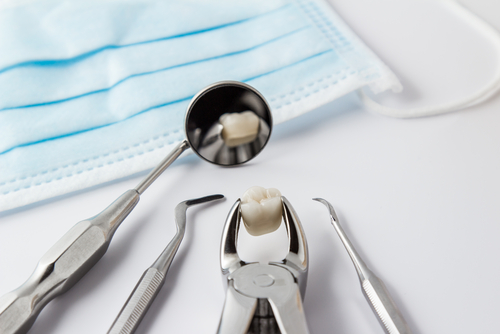Dental procedures known as teeth extractions involve taking a tooth out of its socket in the jawbone. Even though getting a tooth extracted can seem scary, knowing what to expect can help you feel less nervous and have a more positive experience. A tooth extraction may be required for a number of reasons, such as extensive decay and damage, infection, or crowding. No matter what the reason, having a tooth extracted by a dentist or oral surgeon is typically a simple process.
 A comprehensive examination by a dental practitioner is the first step in the extraction of a tooth. The dentist will examine the tooth’s condition, determine any possible risks, and go over the procedure with the patient during this assessment. To obtain a more precise image of the position and structure of the tooth, X-rays might be taken. The dentist will decide whether a simple extraction or a surgical extraction is necessary based on this examination.
A comprehensive examination by a dental practitioner is the first step in the extraction of a tooth. The dentist will examine the tooth’s condition, determine any possible risks, and go over the procedure with the patient during this assessment. To obtain a more precise image of the position and structure of the tooth, X-rays might be taken. The dentist will decide whether a simple extraction or a surgical extraction is necessary based on this examination.
Teeth that are easily extracted with forceps and that are visible in the mouth are usually the targets of simple extractions. To reduce pain, a local anesthetic is used to numb the area around the tooth before the procedure starts. The dentist uses specialized tools to gently remove the tooth from its socket after numbing the surrounding tissue and the tooth itself. During the extraction, patients might feel some pressure, but they shouldn’t feel pain.
When a tooth is impacted or difficult to reach, surgery might be required to remove it. Because of the complexity of this procedure, the patient may need to be sedated or given general anesthesia to ensure comfort. In order to access the tooth during a surgical extraction, the dentist makes a tiny incision in the gum tissue. To make the tooth easier to remove, it might occasionally be necessary to section it into smaller pieces. After the tooth is removed, the wound is sutured shut and gauze is applied to the area to stop the bleeding.
Following a tooth extraction, some soreness and swelling are typical. Instructions on how to take care of the extraction site and deal with any pain or swelling will be given by the dentist. Usually, after the procedure, patients are instructed to limit their physical activity and eat only soft foods. To encourage appropriate healing and lower the risk of complications, it is imperative that you carefully adhere to these post-operative instructions.
The healing time following a tooth extraction is typically not too long. Any discomfort should go away in a few days as the extraction site heals gradually over the next few weeks. Maintaining proper oral hygiene during this period is crucial, and this includes gently brushing and flossing the area surrounding the extraction site. It is crucial to get in touch with the dentist right away if the pain doesn’t go away or gets worse over the course of a few days, or if there are any infection-related symptoms like fever or severe swelling.
Although getting your teeth extracted may seem scary, tooth extractions are a common dental procedure that can successfully treat a variety of oral health problems. Patients can approach the procedure with confidence and achieve a healthy, pain-free smile by being aware of what to expect and the process.